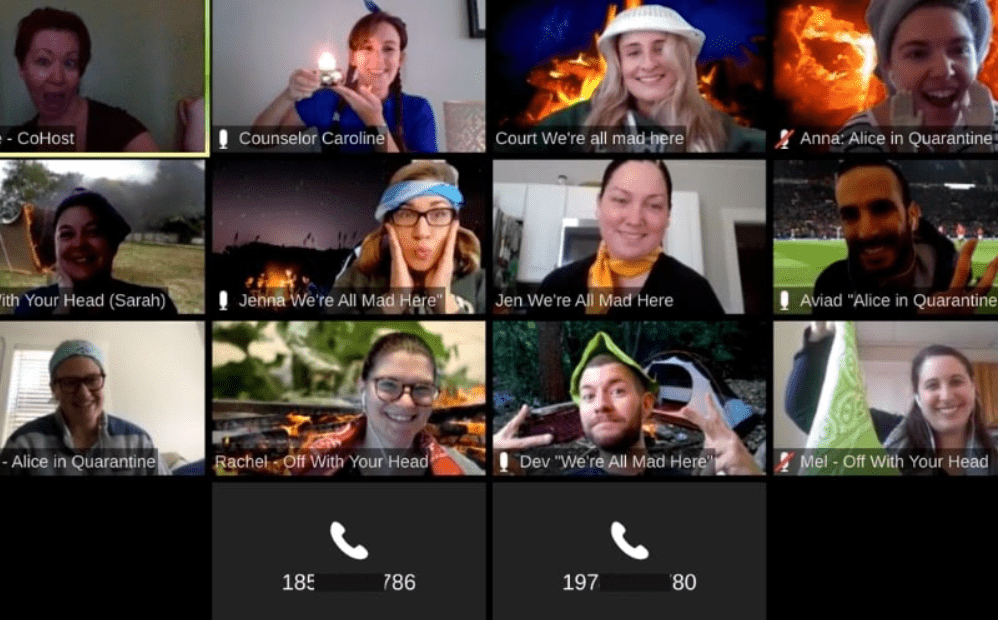You found our article on the latest team building trends.
Team building trends are current crazes in the team building industry. The types of team building activities that leaders choose reflects the visions for the future of organizations. The current trends in team building also mirror employees’ desires for a different sort of workplace.
These trends continue on the history of team building, and support the benefits of team building at work. The data has some intersections with remote work trends.
This list includes:
- trends in team management
- team building industry trends
- team development trends
- virtual team trends
Here is the list!
List of team building trends
From virtual team building, to diversity-related team building, to customizable team building, here is a list of trends that set the tone for the future of team bonding.
1. Virtual team building

Undoubtedly, virtual team building is one of the most popular team building trends of the year, and will continue to gain traction as remote work becomes a mainstay. According to estimates from Upwork, by 2028 73% of all teams will include remote workers. Virtual team building is attractive not only to dispersed teams, but also to teams who have circumstances, such as caretaking duties or frequent travel, that might otherwise inhibit attendance at team building events.
One of the major perks of virtual team building is that remote gatherings are an often low-cost, logistically simple way to accommodate small and large groups alike. Online team building encompasses much more than Skype icebreakers and Zoom conference games. TeamBuilding offers online events ranging from murder mysteries to trivia tournaments to tealight s’mores.
Learn more about virtual team building and virtual team bonding, and check out our list of virtual team building events.
2. Hobby-based team building
As employees hunkered down during the 2020 coronavirus quarantine, Instagram exploded with photos of fresh-baked bread, lush green gardens, and colorful tie-dyed T-shirts. Folks were hungry to try new hobbies, but commuting and traveling from work had prevented their dabbling. Moving forward, smart leaders will note this phenomenon and invest in educational and recreational hobby-based team building activities sure to draw a crowd.
Examples of hobby-based team building activities:
- Cooking class
- Wood Etching
- Coding camp
- Craft night
- Improv or standup comedy class
- Bullet journaling lesson
- Marie-Kondo-style home organization
- Martial arts or self defense class
- Coffee roasting
Unconventional options like lock picking tutorials (for fun only, of course!) or graffiti lessons could make for a fun and unexpected bonding experience.
Hobbies help employees destress and unwind, providing an outlet for tension. The Harvard Business Review reports that hobbies can boost workers’ creativity and confidence. These pastimes teach skills that can come in handy on the job in unexpected ways. Furthermore, hobbies provide a conversation topic that can help employees connect with clients or coworkers.
Check out this list of online cooking classes, and these virtual art classes for examples.
3. Diversity-related team building
As a racial reckoning sweeps through corporate America, diversity in the workplace becomes an ever-increasing priority. Stories of discrimination, exclusion, and microaggressions at work highlight how underinformed about these issues many companies have been. As a result, diversity training is on the rise, and so is diversity-related team building. Diversity-related team building approaches collaboration through the lens of learning and understanding with the unique experiences of distinct identities. The end goal is to promote a culture of empathy and inclusion.
Other examples of diversity-related team building:
- Drag-show followed by Q&A with a queen
- Language lessons
- Bilingual instructions at an event like yoga
- Storytelling workshops
- Compare & contrast activities, such as games of word association
- Virtual holiday parties for non-mainstream holidays
- Volunteering with underrepresented groups
- History lesson on a concept not covered in schools
Diversity-based team building is one of the most important recent team building trends. Schools and society often do not adequately cover these issues, but a diversity-focused team building initiative can help fill in the gaps.
Staff members may volunteer to lead these initiatives, yet you should not make it the responsibility of the employee to educate their peers. Instead, you should enlist a third party to lead topics and exercises. For best results, these activities should be ongoing and should cover a wide range of subjects such as race, gender, orientation, disability, nationality, and class.
Learn more about diversity and inclusion activities for remote teams.
4. Learning-based team building

Our quick-moving, ever-evolving world demands that employees keep learning and growing. Not to say that fact is necessarily bad. Most folks enjoy learning and growing, but many struggle to find the time to study on top of work, family, and other obligations. Learning-based team building is one of the most helpful team development trends for busy professionals. By embracing educational team building, you help your employees learn on the clock while bonding with coworkers.
Examples of learning-based team building:
- Lunch and learns
- Team certification courses
- Peer-taught lessons
- Group classes, such as ukulele-building, coding, or cooking classes
Learning-based team building is especially useful for new teams because mastering a new skill gives teammates common ground and talking topics, and also requires team members to show vulnerability. Also, learning together can be more effective than learning alone, since colleagues can discuss the lessons and reinforce the knowledge.
5. Resilience-centered team building
As the saying goes, “tough times don’t last; tough teams do.” Trials fill the modern workplace, from work-life balance to global crises to interpersonal issues to plain old bad days. To thrive in a challenging and ever-changing work environment, employees must develop resilience. On an individual level, resilience means regulating emotions, meeting challenges, and gracefully adapting to change. To teams, resilience means working together, supporting each other, following through on duties, and re-assigning roles or tasks as necessary.
Resilience-centered team building consists of group activities that develop the skills needed to face adversity, and is one of the quickest-growing trends in team management.
Examples of resilience-centered team building:
- Obstacle courses
- Meditation and stress-management sessions
- Emotional intelligence seminars
- Leadership training
- Team runs, triathlons, or marathons
This form of team building centers on overcoming challenges and teaches skills to cope with stress. Instead of counting on employees to build these capabilities individually, this method takes a proactive approach and gives teammates the resources to manage stressors.
6. Customizable team building
Because every team is unique, a one-size-fits all approach to team building seems silly. One of the most popular team building industry trends is customizable team building. Leaders want activities tailored to their teams when possible. Custom-built activities or distinct touches make team building feel more personal. The team feels special, and the unique experience helps form a solid group identity.
Examples of customizable team building include incorporating company logos into event decorations and swag or allowing organizations to select a program of events to design a team building day. Some companies will build a scavenger hunt from scratch or create a custom quiz. TeamBuilding tries to make events as unique and useful to clients as possible. For instance, we allow clients the option to choose themes for Virtual Team Trivia, and build a custom game around topics of choice.
With customizable team building, you can target certain competencies or specific industries. Tweaking the experience makes the activity feel more relevant and helps you to achieve your team building goals.
7. Experience-centered team building
Folks want to connect meaningfully and participate in interesting experiences. Experienced-centered team building accomplishes both aims. This team building trend focuses on the quality of the event in areas such as novelty, social interaction, and learning quotient. Experience-centered team building aims to engage employees through fun activities, new ideas, significant connections, and an overall good time.
Examples of experience-centered team building:
- Team lunches or dinners
- Paint and sip classes
- Escape rooms
- Group karaoke
- Team hikes
New experiences offer a bonding opportunity for teammates. Fun events drum up excitement and boost attendance for outings. These events use the activity as a starting point to reimagine the team building experience. Some companies assume that more money spent equals a better event, but successful team activities are more about the quality of the experience than the expense.
Teammates who enjoy themselves and genuinely have fun at events do not dread team building and are more likely to cooperate in the future. Experience-based team building is also one of the most popular virtual team trends, as remote teams have fewer opportunities to interact, and memorable activities can help accelerate the formation of work friendships.
Conclusion
Signs point to lasting shifts in the way we work and collaborate. The items on this list are the latest team building trends, but themes like virtual teamwork, diversity and inclusion, and learning are likely to stick around and make waves in the upcoming years.
Leaders who embrace these trends position themselves ahead of the curve and prepare their organizations for the future.
For more information on the current state of teamwork, check out our article on team building statistics and this one with reasons why team building is important.
We also have a guide on how to do team building days for your staff, one on ideas for returning to the office, one on team building interventions and a post on team building management skills.
